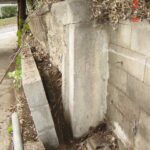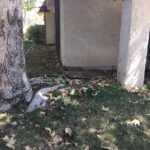 In hot, dry, crowded Southern California, many people are attracted by those resort style or park-like homes set on ocean-view or urban forest lots. They tug at every nature lover’s heart. You fall in love with statuesque Palms or the sculpted limbs of old California Oaks or evergreen Cedars or stately Sycamores or fragrant Eucalyptus surrounded by beautiful lawns and beds full of shrubs and flowers.
In hot, dry, crowded Southern California, many people are attracted by those resort style or park-like homes set on ocean-view or urban forest lots. They tug at every nature lover’s heart. You fall in love with statuesque Palms or the sculpted limbs of old California Oaks or evergreen Cedars or stately Sycamores or fragrant Eucalyptus surrounded by beautiful lawns and beds full of shrubs and flowers.
I love trees too. Trees provide shade and are awesome to look at. There is, however a big downside to trees placed too closely to homes. They look great when you buy the home or when you plant those stick-like saplings. Years later, unfortunately, we are often asked by property owners and insurance companies to evaluate the structural damage after large trees fall or invasive tree roots cause harm.
Wind Damage
 Strong winds, especially in Santa Ana season, often cause trees and branches to fall onto homes and can cause catastrophic damage. Most of the time, the impact of falling tree branches damages the roof, the roof sheathing and the roof framing of the structure. You’ll occasionally see TV news coverage as utility or city crews begin to remove limbs, but there is a backstory here that you’ll hopefully never get to see.
Strong winds, especially in Santa Ana season, often cause trees and branches to fall onto homes and can cause catastrophic damage. Most of the time, the impact of falling tree branches damages the roof, the roof sheathing and the roof framing of the structure. You’ll occasionally see TV news coverage as utility or city crews begin to remove limbs, but there is a backstory here that you’ll hopefully never get to see.
At Helfrich-Associates, we are often hired for home restoration projects after the damage is done by high winds and falling trees. Before clean-up, we must first review the structural damage to the home and then develop a plan for temporarily shoring up the undamaged part of the roof so that the tree branches are removed safely without causing more damage or hurting anyone or neighboring homes.
Next we develop repair plans to address the damage, and it often takes months to complete the repairs before the homeowners can move back in. You’ll never see the after-effects of fallen tree damage on TV or hear the sad homeowner stories or know what had to be done that wasn’t obvious to bring a home back up to code during a restoration or what was/wasn’t covered by insurance, etc.
The Root of the Problem
 Tree root growth can cause severe damage to structures, concrete patios, roadways, septic tanks, utility vaults and sidewalks. Although this is typically considered long-term damage (occurring over years as the tree roots grow and lift or penetrate structures), owners are unaware of the damage until it causes difficulty with opening doors and windows, or cracks appear in a home’s walls, ceiling and foundation. Tree roots will search for water no matter where it is found. Plumbing leaks, for example, can start and go on for many years before they are noticed, attracting tree roots to the source of water. Once the roots find a leaking pipe, they will often enter the pipe, causing drain backups and blockages. Tree roots (depending on the species) are generally estimated to extend to the area covered by the tree canopy.
Tree root growth can cause severe damage to structures, concrete patios, roadways, septic tanks, utility vaults and sidewalks. Although this is typically considered long-term damage (occurring over years as the tree roots grow and lift or penetrate structures), owners are unaware of the damage until it causes difficulty with opening doors and windows, or cracks appear in a home’s walls, ceiling and foundation. Tree roots will search for water no matter where it is found. Plumbing leaks, for example, can start and go on for many years before they are noticed, attracting tree roots to the source of water. Once the roots find a leaking pipe, they will often enter the pipe, causing drain backups and blockages. Tree roots (depending on the species) are generally estimated to extend to the area covered by the tree canopy.
If, for example, tree branches extend over your roof, the roots probably are growing under your foundation at this very moment. Once the roots are below your foundation, they will sooner or later lift the foundations and slabs several inches unless they are treated first.
I remember a home in South Pasadena that had a more than 4-foot trunk diameter tree planted within a couple of feet from the foundation. The tree had lifted the house’s foundation by about 6 inches. The required repairs included tree, stump and root removal; as well as stabilizing and repairing the foundation plus repairs to damage inside the home. None of the damage was covered by insurance
My Advice
 I love trees, but keep them well away from your home, patio, pool, etc. How far away is safe? It depends on the tree species and its growing habits. If you’re moving into a brand new home, or are updating an existing home, or are worried about trees on your classic property, start by contacting a reputable arborist or landscape architect. Local plant nurseries also offer excellent landscape advice.
I love trees, but keep them well away from your home, patio, pool, etc. How far away is safe? It depends on the tree species and its growing habits. If you’re moving into a brand new home, or are updating an existing home, or are worried about trees on your classic property, start by contacting a reputable arborist or landscape architect. Local plant nurseries also offer excellent landscape advice.
Winter is an excellent season to address over-size trees and tree root problems. If your tree can be saved, it is best to give it a good trim while it is resting and this is where an arborist can help. On the other hand, if you’re already experiencing symptoms of damage such as overgrown limbs brushing the structure during wind storms or cracked limbs leaning into your home or roots lifting the foundation, now is the time to call us for a structural assessment and remediation plan to prevent further damage.
